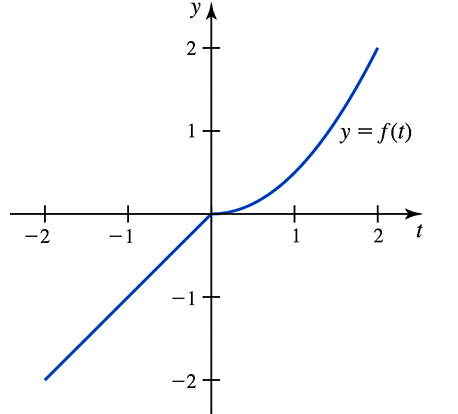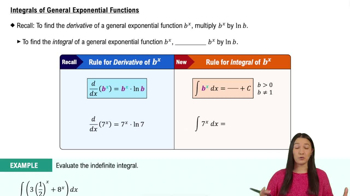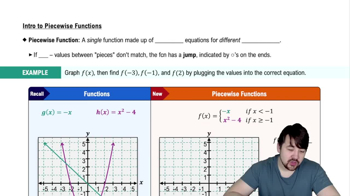Determine the intervals on which the function g(𝓍) = ∫ₓ⁰ t / (t² + 1) dt is concave up or concave down.
Table of contents
- 0. Functions7h 54m
- Introduction to Functions16m
- Piecewise Functions10m
- Properties of Functions9m
- Common Functions1h 8m
- Transformations5m
- Combining Functions27m
- Exponent rules32m
- Exponential Functions28m
- Logarithmic Functions24m
- Properties of Logarithms36m
- Exponential & Logarithmic Equations35m
- Introduction to Trigonometric Functions38m
- Graphs of Trigonometric Functions44m
- Trigonometric Identities47m
- Inverse Trigonometric Functions48m
- 1. Limits and Continuity2h 2m
- 2. Intro to Derivatives1h 33m
- 3. Techniques of Differentiation3h 18m
- 4. Applications of Derivatives2h 38m
- 5. Graphical Applications of Derivatives6h 2m
- 6. Derivatives of Inverse, Exponential, & Logarithmic Functions2h 37m
- 7. Antiderivatives & Indefinite Integrals1h 26m
- 8. Definite Integrals4h 44m
- 9. Graphical Applications of Integrals2h 27m
- 10. Physics Applications of Integrals 3h 16m
- 11. Integrals of Inverse, Exponential, & Logarithmic Functions2h 34m
- 12. Techniques of Integration7h 41m
- 13. Intro to Differential Equations2h 55m
- 14. Sequences & Series5h 36m
- 15. Power Series2h 19m
- 16. Parametric Equations & Polar Coordinates7h 58m
8. Definite Integrals
Fundamental Theorem of Calculus
Problem 5.R.105d
Textbook Question
Area functions and the Fundamental Theorem Consider the function
ƒ(t) = { t if ―2 ≤ t < 0
t²/2 if 0 ≤ t ≤ 2
and its graph shown below. Let F(𝓍) = ∫₋₁ˣ ƒ(t) dt and G(𝓍) = ∫₋₂ˣ ƒ(t) dt.

(d) Evaluate F ' (―1) and F ' (1). Interpret these values.
 Verified step by step guidance
Verified step by step guidance1
Step 1: Recall the Fundamental Theorem of Calculus, which states that if F(x) = ∫ₐˣ ƒ(t) dt, then F'(x) = ƒ(x). This means the derivative of the area function F(x) is equal to the value of the function ƒ(x) at x.
Step 2: To evaluate F'(−1), observe that F'(x) = ƒ(x). From the graph and the piecewise definition of ƒ(t), for −2 ≤ t < 0, ƒ(t) = t. Therefore, ƒ(−1) = −1.
Step 3: To evaluate F'(1), observe again that F'(x) = ƒ(x). From the graph and the piecewise definition of ƒ(t), for 0 ≤ t ≤ 2, ƒ(t) = t²/2. Therefore, ƒ(1) = (1²)/2 = 1/2.
Step 4: Interpret the values: F'(−1) = −1 indicates that at x = −1, the rate of change of the area function F(x) is equal to the value of ƒ(t) at t = −1, which is −1. Similarly, F'(1) = 1/2 indicates that at x = 1, the rate of change of the area function F(x) is equal to the value of ƒ(t) at t = 1, which is 1/2.
Step 5: The values of F'(−1) and F'(1) provide insight into how the function ƒ(t) contributes to the accumulation of area in F(x) at specific points. Negative values of ƒ(t) (e.g., at t = −1) reduce the accumulated area, while positive values (e.g., at t = 1) increase it.
 Verified video answer for a similar problem:
Verified video answer for a similar problem:This video solution was recommended by our tutors as helpful for the problem above
Video duration:
3mPlay a video:
Was this helpful?
Key Concepts
Here are the essential concepts you must grasp in order to answer the question correctly.
Fundamental Theorem of Calculus
The Fundamental Theorem of Calculus links the concept of differentiation and integration, stating that if F is an antiderivative of f on an interval [a, b], then the integral of f from a to b is equal to F(b) - F(a). This theorem allows us to evaluate definite integrals and understand the relationship between a function and its area under the curve.
Recommended video:

Fundamental Theorem of Calculus Part 1
Derivative of an Integral Function
When evaluating the derivative of an integral function, such as F(x) = ∫₋₁ˣ f(t) dt, we apply the Fundamental Theorem of Calculus. The derivative F'(x) gives us the value of the integrand f evaluated at the upper limit of integration, which provides insight into the rate of change of the area under the curve as x varies.
Recommended video:

Integrals of General Exponential Functions
Piecewise Functions
A piecewise function is defined by different expressions based on the input value. In this case, the function f(t) has two distinct expressions depending on whether t is less than 0 or between 0 and 2. Understanding how to evaluate and differentiate piecewise functions is crucial for correctly applying calculus concepts to such functions.
Recommended video:

Piecewise Functions

 6:11m
6:11mWatch next
Master Fundamental Theorem of Calculus Part 1 with a bite sized video explanation from Patrick
Start learningRelated Videos
Related Practice
Textbook Question
13
views
